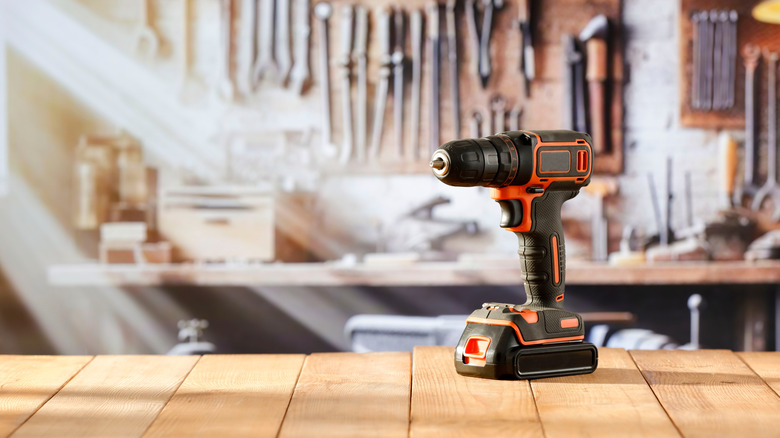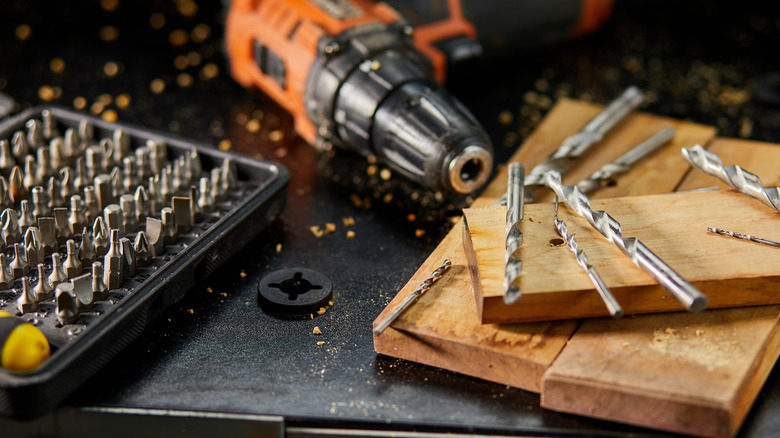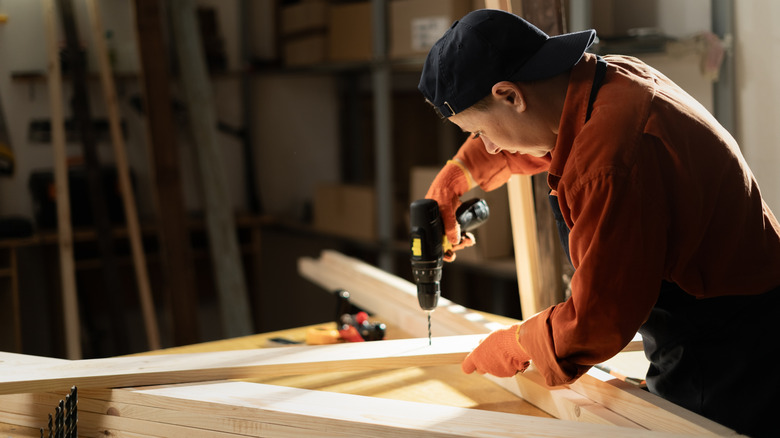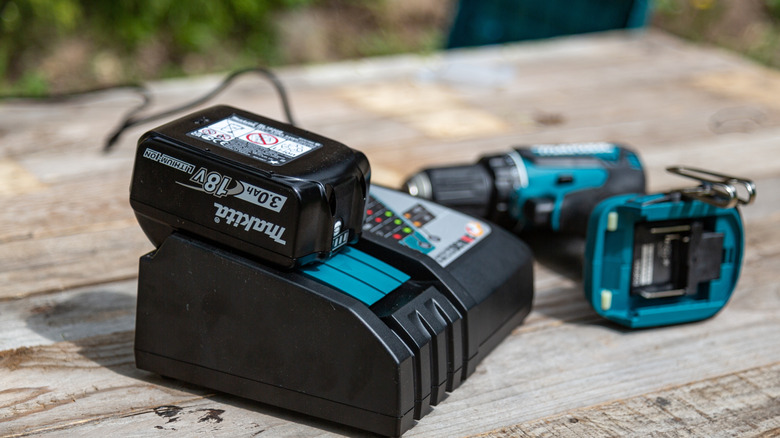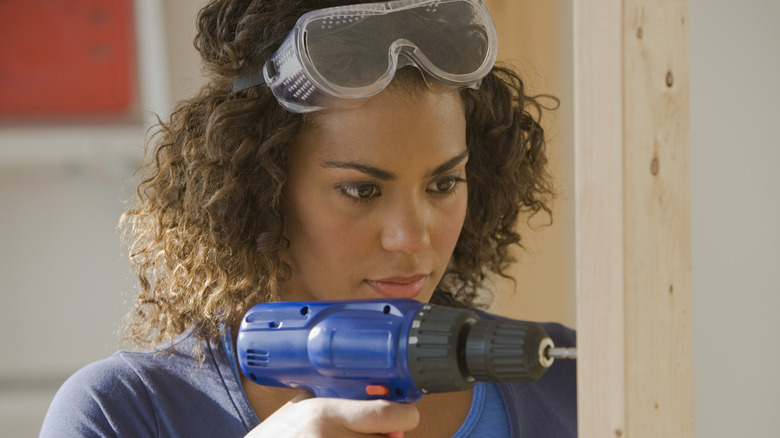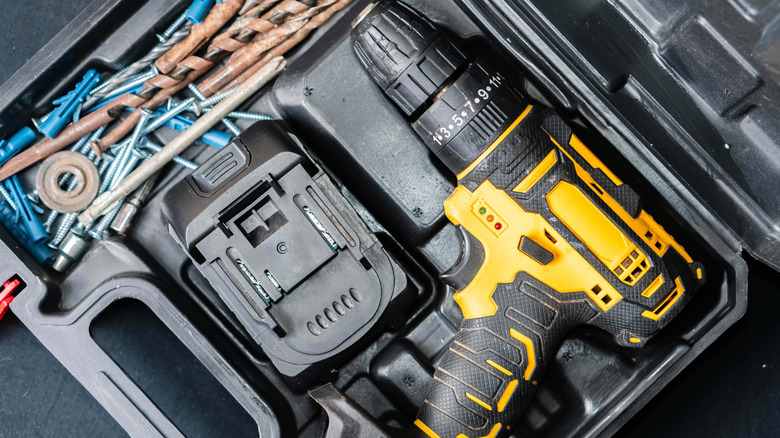Using A Cordless Drill? Avoid These 5 Common Mistakes At All Costs
A cordless drill is a handy item to have in your toolbox to tackle all sorts of tasks. Without being tethered to a cord and a nearby outlet, you can take your projects on the road with the lightweight, portable tool. Even the cheapest cordless power drill lets you create pilot holes, drill wall studs, and handle other basic tasks. The cordless drill is a relatively easy tool to learn how to use, but there's still room for error, especially when it comes to the details and advanced uses. Common mistakes include using the wrong drill bit, not knowing how the controls work, not maintaining your tool, not taking safety measures, and not having a backup power source.
What happens if you make these common cordless drill mistakes? It could affect the outcome of your project, potentially damaging the materials or keeping you from attaching pieces securely. Some mistakes shorten the life of the tool by putting excess strain on it. You could also injure yourself if you use the cordless drill incorrectly. Common injuries include puncture wounds, cuts, entanglement, eye injuries, and burns. Being aware of the common cordless drill mistakes helps you improve your habits to get more out of the drill.
Choosing the wrong drill bit
Cordless drills accept a variety of drill bits, but not all drill bits work for the same jobs. Using the wrong bit could prevent the drill from doing its job, damage the surface you're drilling, ruin the bit, or strain the drill. Your cordless drill's chuck size determines the largest drill bit you can use with the tool. Larger bits won't fit unless you use an adapter or choose bits with smaller stepped-down shanks.
Specialty bits designed for specific materials have unique features to make them better suited for that surface. For example, masonry bits are made to drill into concrete, stone, and brick. They're often built with a strong steel shaft and a tungsten carbide tip. You can also find tile, glass, and mortice drill bits. Using the wrong type of drill bit could cause damage to the item. It often makes the job more difficult and less efficient.
Knowing how to choose which drill bit to use improves the outcome. A new cordless drill comes with at least a few bits, but you may need additional options to match specific jobs. Consider how you plan to use your cordless drill, including the sizes of the holes and the materials you'll drill, to buy compatible drill bits for those jobs. Before using a drill bit, you should also check its condition to verify that the cutting edges are still sharp and that the shank is straight. Dull, dirty, or damaged drill bits won't work as effectively, even if they're the correct type.
Not understanding the controls
Most cordless drills feature adjustable torque and speed settings to give you more control. Changing the settings makes the tool better suited for different tasks. You typically control the speed based on how hard you squeeze the drill trigger. Using the wrong speed or torque can damage the material you're drilling or make it difficult to drill a hole. It can also cause you to install the screw too deeply or damage the screw.
The torque setting controls how much rotational force goes into the screw that you're attaching. You can usually adjust this setting with the clutch on the drill collar with lower numbers meaning a lower torque setting. If you're using a faster speed, you typically use a lower torque setting. The opposite is also true: slower speeds go along with higher torque.
The material you're drilling impacts the speed and torque you should choose. If you're drilling into wood or other softer materials or are using smaller screws, higher speeds work best to protect the material and allow the screw to go into the surface without splintering it. When you're working with harder surfaces or are using larger screws, slowing down the speed and increasing the torque allows the drill to move through the material effectively. Playing with the settings using scrap material helps you get a better feel for the different levels on your drill. You might notice differences in the torque and speed between various power tool brands and models.
Not having enough power
A traditional corded drill has a consistent power source as long as it's plugged into an outlet. With a cordless model, the battery gradually slows down as you use it, eventually causing a noticeable change in how much power you feel behind the tool. That's when you need to recharge the battery. Continuing to use the drill means it may not have enough power to work efficiently. You might also cause damage to the battery and shorten how long it lasts if you use the drill until the battery dies completely. Having extra drill batteries on hand allows you to keep working if you're doing a larger project.
When charging your drill batteries, only use the charger that comes with the drill or replacement power tool accessories recommended by the manufacturer. Using a universal charger could cause the battery to become undercharged or overcharged. It's usually best to remove the battery from the charger once it's fully charged, but some manufacturers build in safety features to avoid overcharging or other effects. If a charged battery sits unused for a long period, it naturally starts to lose its charge. Using your drill every few weeks helps the tool maintain its battery charge for longer than it would if it sat completely unused.
Store the extra batteries in a cool, dry place to make them last longer. Extreme temperatures can affect the battery's performance. Moisture can also damage the batteries by causing corrosion.
Forgetting safety precautions
A cordless drill may seem harmless, but the moving parts and the particles the drill creates can cause injuries. Safety goggles reduce the risk of eye injuries, which can happen if pieces of wood, concrete, or other materials you're drilling fly. You don't have to worry about tripping over a cord, but you could face entanglement issues with the moving parts. Avoid wearing loose clothes or letting your hair dangle, which can get caught on the rotating drill bit. The dust generated from drilling concrete contains silica, which is dangerous to inhale. A respirator can help protect you from breathing it in.
Working on a secure surface is also important. Make sure you know what's behind the surface you're drilling to avoid the kickback that can happen if you hit something. You could also damage plumbing and electrical lines if you drill into a wall blindly. If you're drilling an item that's not anchored to anything, place it on a flat, stable surface that can take some pressure. The vibrations and pressure from the drill could cause an unstable work surface to collapse or wobble, potentially damaging your project and causing injury.
Maintain control by using both hands on the drill. Keep your fingers, face, and other body parts away from the rotating drill bit to prevent injuries. Let the drill do most of the work. Pushing on the drill too much could cause it to slip, which increases your risk of an injury.
Failing to maintain the drill
Proper maintenance and storage can extend the life of your power tools. Drilling any material creates dust that can blanket the cordless drill and settle into the air intake and vents. Dusting off the drill after each use helps get rid of that debris and prevent clogs that could lead to overheating. Compressed air is a simple way to clear away dust from the ventilation slots on the drill. Cleaning the chuck is also important as small pieces of debris can get jammed in that area.
Lubrication is also helpful for keeping your drill moving without too much friction. Moving parts, particularly the chuck, benefit from occasional lubrication. Every model is different, so check the owner's manual to determine what type of lubricant to use, where to apply the oil, and how often to lubricate. Drill bit maintenance also improves your drill's performance. Dull drill bits can't cut through materials as effectively, which may cause you to press harder on the drill. That can cause damage to your drill and the material you're drilling into. Sharpening dull drill bits is an option to keep your drill working smoothly. You might also replace dulling drill bits if you don't want to sharpen them.
Store your properly maintained drill in its original case if you still have it. You can also store it in a secure toolbox or another area where it's protected from sunlight. Choose an area away from extreme temperatures and high humidity.
